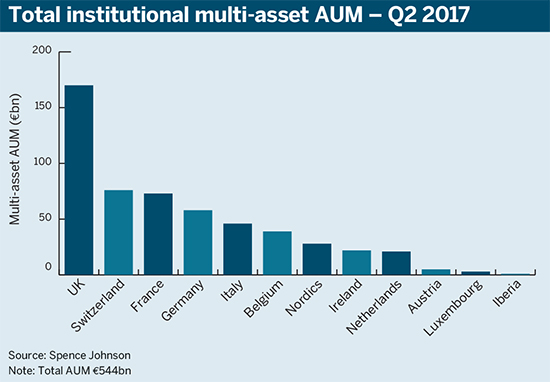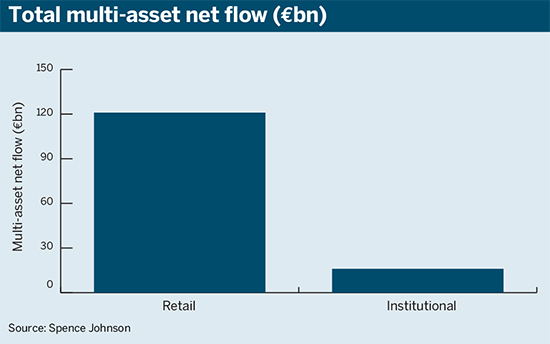Diversified growth funds have been a popular investment choice in the past years; Magnus Spence from market research company Spence Johnson looks at the challenges these products might encounter.
There was a time when multi-asset meant balanced, and sophisticated larger institutional investors were easily persuaded by consultants to avoid such ‘primitive’ vehicles. They were asked to focus instead on myriad single asset class strategies – with consultants as the alchemists of course, helping to blend them into a coherent portfolio.
The larger consultants have now eased off the recommendation of multi-asset as their fiduciary businesses have risen
This started to change from the 2000s, when flexible asset allocation funds known in the UK mostly as diversified growth funds started to emerge, initially in the teeth of larger consultants’ resistance, but gradually winning over smaller pension schemes in particular with the promise of diversification without governance headaches.
Multi-asset is hard to define
The multi-asset market in Europe is far wider than just DGFs of course. It encompasses €1.8tn (£1.6tn) in assets, more than 9,800 funds and thousands of segregated mandates.
It is also diverse and very difficult to define. Our analysis encompasses a range of multi-asset funds from the old-style long-only balanced funds, through to solutions and absolute return multi-factor strategies.
This range incorporates funds that are classified as dynamic, income, target maturity and asset allocation, as well as alternative, lifecycle, and funds of funds.
Of the €1.8tn, only 30 per cent sits within pure institutional portfolios, which excludes family office, private bank, asset manager and sub-advisory activities. The UK pensions market has historically been the heartland of institutional multi-asset activity in Europe; it remains the largest by assets, followed by Switzerland.

When looking just at new business, the demand among institutional investors is being outstripped by that from retail, to the extent that multi-asset can now be said to be overwhelmingly a retail/wholesale opportunity.
In the 12 months up to end of June 2017, there were €120bn (£105bn) of retail multi-asset flows in Europe, compared with €16bn (£14bn) in institutional.

Will DGFs retain their lustre?
Back in the UK institutional space, DGFs have been the most popular form of multi-asset. As of Q2 2016, £67bn of UK defined benefit assets were invested in DGFs, with the bulk of this in absolute return DGFs priced between 70-79 basis points. Net flow data highlights a growing concentration of assets within strategies in this price range.
But UK pension investment patterns are, as is well known, changing. Among DB schemes, derisking is leading to a shift into alternatives and fixed income, and this will have an impact on demand for multi-asset.
Recent flows into DGFs have probably slowed also because of the pooling of Local Government Pension Scheme assets, and an increasing focus on investments that can deliver contractual cash flows.
Multi-asset in UK institutional also faces distribution challenges. The larger consultants in the UK that in the 2000s were so opposed to DGFs, but who came round to them during the past 10 years, have now eased off the recommendation of multi-asset as their fiduciary businesses have risen. Mercer and Willis Towers Watson also have competitor fund of funds multi-asset offerings.
But despite these conflicts, they are still placing multi-asset mandates. Mercer placed £775m into idiosyncratic DGFs in the year up to Q2 2017. Smaller consultants such as LCP and Hymans Robertson have been supporters of multi-asset, and do not have fiduciary offerings to complicate their message.
Among UK defined contribution schemes, DGFs have established themselves as a key component within default funds. In a recent survey of larger UK DC schemes, we established that one-third of these schemes’ assets are in multi-asset offerings, mostly DGFs.
Multi-asset demand is adapting to a post-charge cap environment with a new pricing normal of less than 25-40bp. Multi-asset strategies priced at less than 40bp have been the primary beneficiaries.
DGFs are also beginning to come under pressure from a greater use of architecture target date funds in DC, and open architecture target date funds in particular.
So multi-asset has established itself as a key component of many UK pension scheme portfolios, but it faces a challenging future if it is to maintain its progress.
Magnus Spence is managing director of Spence Johnson, a Broadridge Company













